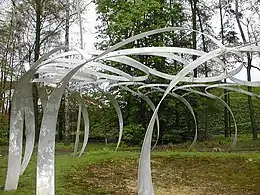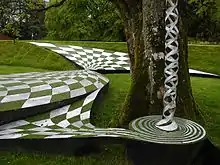Garden of Cosmic Speculation
The Garden of Cosmic Speculation is a 30 acre (12 hectare) sculpture garden created by landscape architect and theorist Charles Jencks at his home, Portrack House, in Dumfriesshire, Scotland. Like much of Jencks' work, the garden is inspired by modern cosmology.

History
Features

The garden is inspired by science and mathematics, with sculptures and landscaping on these themes, such as black holes and fractals.[1] The garden is not abundant with plants, but sets mathematical formulae and scientific phenomena in a setting which elegantly combines natural features and artificial symmetry and curves. It is probably unique among gardens, drawing comparisons with a similarly abstract garden in Scotland, Little Sparta.
Access
The garden is private but usually opens for only five hours on one day each year for 1500 ticket holders through the Scotland's Gardens programme and raises money for Maggie's Centres, a cancer care charity named for Maggie Keswick Jencks, the late wife of Charles Jencks.[2]
Depiction in music
The garden is the subject of an orchestral composition by American composer, Michael Gandolfi, which he composed for a joint commission from the Boston Symphony Orchestra and the Tanglewood Music Center. The piece was subsequently recorded by the Atlanta Symphony Orchestra conducted by Robert Spano, and nominated for "Best Contemporary Classical Composition" at the 2009 Grammy Awards.
In literature
Louise Penny uses The Garden of Cosmic Speculation as an important plot device in her tenth Inspector Gamache mystery, The Long Way Home (St. Martin Press, 2014).[3]
Cameron Jace makes creative use of The Garden of Cosmic Speculation in his fictional novel titled Circus, which is the third installment of his Insanity series. In the book, Jace uses many true facts when referring to 'public' knowledge of the garden (per character conversation), but changed the name of the designer to better fit into the story's plot line.
See also
References
- "Symmetry, Chaos, Nature and Science in the 'Cosmic Speculation' Garden 20 Photos (from Turkish: Simetri, Kaos, Tabiat ve Bilimin Bir Araya Geldiği 'Kozmik Spekülasyon' Bahçesinden 20 Fotoğraf)". Onedio. 14 March 2015. Retrieved Nov 26, 2018.
- "Curious Fact of the Week: Garden of Cosmic Speculation". Atlas Obscura. May 13, 2013. Retrieved Nov 26, 2018.
- Oldenburg, Dan (2014-08-25). "Inspector Gamache returns in Penny's The Long Way Home". USA Today.
External links
| Wikimedia Commons has media related to Garden of Cosmic Speculation. |
- Charles Jencks website
- 'Cosmic Speculation' Garden - 20 Photos
- The Garden of Cosmic Speculation at Amazon Books
- Scotland's Gardens Scheme
.jpg.webp)